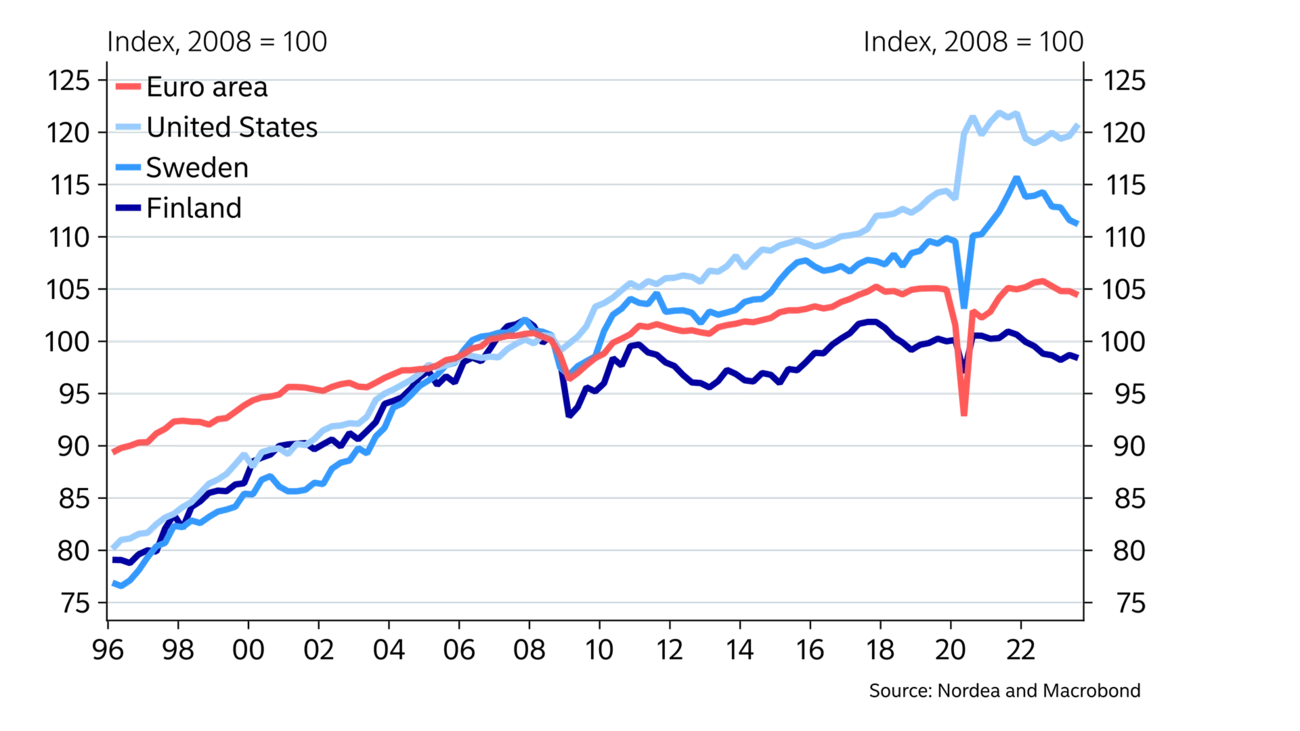
- Name:
- Juho Kostiainen
- Title:
- Nordea Senior Analyst
Finland is in desperate need of investments in education, research and development in order to boost productivity growth, which has stalled for the past 15 years, to being on par with peer countries. Higher interest rates, a weaker economic cycle and the ongoing technological disruption pose challenges to the economy, but also create opportunities for business renewal.

Labour productivity has not grown in Finland for the past 15 years, falling behind many peer countries, such as Sweden and the US.
There are several reasons behind the weak trend in productivity. The disappearance of the highly productive mobile phone sector from Finland explains the first slump after 2008. In 2010-15, productivity growth was hampered by rapid globalisation, coupled with weak competitiveness, as a result of which, industrial production moved out of Finland. More factories were closed than new capacity was built. Investments in research and development also decreased significantly in the 2010s, still remaining below the level seen in 2008.
In recent years, low interest rates and sluggish wage growth have enabled companies with weak productivity to survive, slowing down economic renewal. This trend was prolonged by business subsidies paid out during the pandemic (ETLA Brief No. 131). Finland has also fallen behind in service sector productivity compared to competitor countries.
In addition to stagnant productivity growth in various sectors, changes in the structure of the economy over the past 15 years have also contributed to weaker productivity. High-productivity industries have shed a total of 75,000 jobs, while at the same time, the number of employees in the health care and social services sector has grown by 100,000.

Finland is in need of investments in education, research and development.
Renewal among businesses occurs according to the concept of creative destruction, by which new, more productive companies replace companies with low productivity. The rise in wages and interest rates and economic deterioration are now forcing low-profitability companies to increase their productivity or cease their operations. In fact, bankruptcies in Finland have increased significantly since the end of last year, whereas in the previous two years, the number of bankruptcies was unusually low. However, a lot of new companies have emerged in recent years, so the disappearance of businesses with low productivity will release labour for more productive ones.
In recent decades, positive productivity growth has taken place in the IT sector, which has not only increased its productivity, but also the number of people it employs. The IT sector and artificial intelligence (AI) should contribute considerably to future productivity growth. AI will have an impact on all sectors, improving the availability of labour in an ageing economy.
Among the traditional industrial sectors, the forestry sector has shown innovation in recent years, which is expected to improve the value added, going forward. The green transition may also stop the slide in industrial production, if Finland manages to attract electricity-intensive industrial production and offer new production methods to the rest of the world.
Investing in research and development plays a key role in increasing productivity and growing profitable businesses. Yet, product developers do not grow on trees, and weaker learning scores earned by students in recent years do not bode well for long-term growth in Finland, shattering the country’s narrative of being a nation of competent engineers (ETLA Brief No. 118).
What is now needed in Finland is the courage to invest money, own or borrowed, in refining technologies and business ideas. At the same time, the country must ensure an adequate level of basic and higher education. And, last but not least, Finland must be able to attract and retain educated immigrants.
This article originally appeared in the Nordea Economic Outlook: Past the peak, published on 24 January 2024. Read more from the latest Nordea Economic Outlook.


Sustainability
Amid geopolitical tensions and fractured global cooperation, Nordic companies are not retreating from their climate ambitions. Our Equities ESG Research team’s annual review shows stronger commitments and measurable progress on emissions reductions.
Read more
Sector insights
As Europe shifts towards strategic autonomy in critical resources, Nordic companies are uniquely positioned to lead. Learn how Nordic companies stand to gain in this new era of managed openness and resource security.
Read more
Open banking
The financial industry is right now in the middle of a paradigm shift as real-time payments become the norm rather than the exception. At the heart of this transformation are banking APIs (application programming interfaces) that enable instant, secure and programmable money movement.
Read more